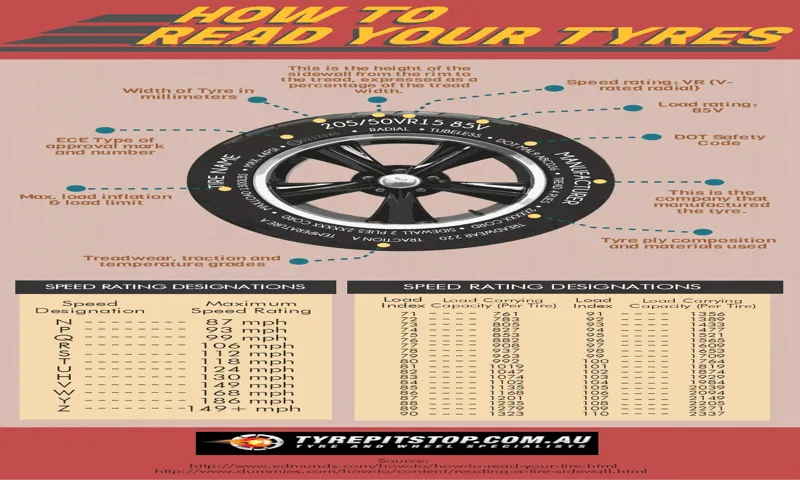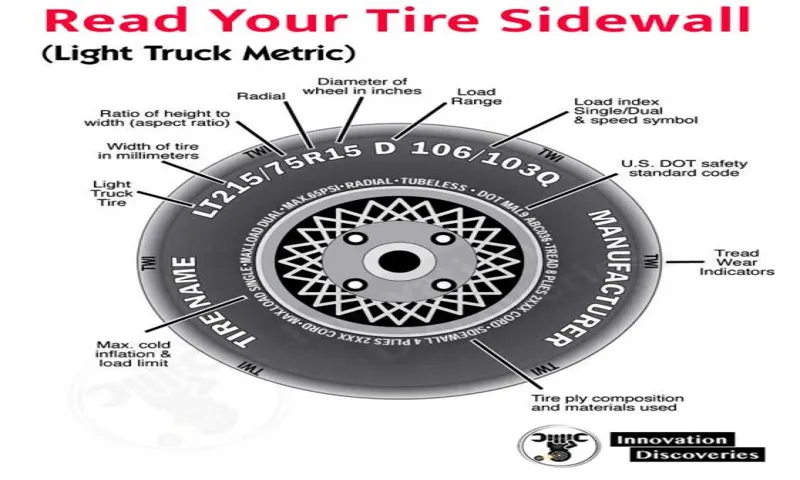Are you having trouble understanding the information on your tire’s sidewall? Don’t worry, you’re not alone! Many people find it difficult to decipher the various letters, numbers, and symbols printed on their tire’s exterior. However, understanding this information is crucial if you want to ensure the safety, performance, and longevity of your vehicle’s tires. In this blog, we’ll guide you through the various components of a tire sidewall and explain what each one means.
By the end of this article, you’ll be able to confidently read and interpret any tire sidewall you come across. So, let’s get started!
Table of Contents
Understanding Tire Markings
If you’ve ever looked closely at a tire sidewall, you may have noticed a series of numbers, letters, and symbols imprinted on it. These markings are crucial in determining the size, type, and performance capabilities of a tire. Learning how to read tire sidewall markings can be a little overwhelming at first, but it’s worth taking the time to understand.
The size of the tire is shown by three numbers, such as “225/55R1” The first number represents the tire’s width in millimeters, the second number indicates the tire’s aspect ratio, and the third number denotes the diameter of the wheel it is intended to fit. Additional markings, such as “XL” for extra load or “M+S” for mud and snow, provide further information about the tire’s capabilities.
By understanding these markings, you can choose the right tire for your vehicle and ensure safe and efficient driving.
Tire Size
When it comes to understanding tire markings, the first thing you need to know is how to read the tire size. The tire size is usually displayed on the sidewall of the tire and consists of a series of numbers and letters. For instance, in the tire size P215/65R15, “P” stands for passenger tire, “215” is the width of the tire in millimeters, “65” is the aspect ratio or height of the tire, “R” stands for radial construction, and “15” is the diameter of the wheel in inches.
Understanding your tire size is important because it affects the handling, braking and overall performance of your vehicle. It’s also important to note that not all tire sizes fit all vehicles, so it’s crucial to refer to your car’s manual or consult a professional if you’re unsure about the correct tire size for your vehicle. Choosing the wrong tire size can lead to various issues, such as poor handling or even accidents.
Overall, taking the time to understand tire markings and size will allow you to make informed decisions when purchasing new tires and help keep you safe on the road.

Tire Type
When it comes to understanding tire markings, it’s important to know the type of tire you need. There are three main types of tires – summer, winter, and all-season – each designed to perform in specific conditions. Summer tires are the best choice for warm temperatures, as they provide excellent handling and traction on both wet and dry roads.
Winter tires, on the other hand, are designed to perform well in cold weather, with specially formulated rubber compounds that maintain their grip in freezing temperatures. Finally, all-season tires aim to provide a compromise between the two, offering decent performance in both summer and winter conditions. When choosing the right tire type for your vehicle, consider the weather conditions in your area and your driving habits to ensure optimal performance and safety.
By understanding tire markings and selecting the right type of tire, you can enjoy a smoother, safer ride all year round.
Load Index and Speed Rating
When choosing new tires for your vehicle, it’s important to understand the markings on the sidewall. One of the most important pieces of information you’ll find is the load index and speed rating. The load index refers to the maximum weight that the tire can support when properly inflated.
A higher load index means the tire can support more weight. Speed rating, on the other hand, refers to the maximum speed the tire can safely operate at. A higher speed rating means the tire can safely withstand higher speeds.
It’s essential to match the load index and speed rating of your tires to your vehicle’s requirements to ensure optimal performance and safety. So, next time you shop for new tires, make sure to pay attention to these important markings to keep your ride safe and smooth.
Identifying Tire Date Code
If you want to know how old your tires are, checking the tire sidewall is the first step. The tire date code, which is usually located on the tire’s sidewall, displays the week and year of production. The code consists of four digits, with the first two digits representing the week and the last two digits representing the year.
For example, if the date code reads 3018, this indicates that the tire was manufactured during the 30th week of 201 It’s crucial to know when your tires were produced because tires have a limited lifespan, and using them beyond their expiration date can potentially lead to dangers on the road. So, read the tire sidewall carefully and take note of the date code to ensure that you’re driving on safe, reliable tires.
DOT Code
If you have ever purchased a new set of tires, you may have noticed a strange code printed on the sidewall. This code, known as the DOT code, is a four-digit number that indicates the manufacture date of the tire. The first two digits represent the week of the year, while the second two represent the year itself.
For example, a DOT code of “0416” would indicate that the tire was manufactured in the fourth week of 201 It’s important to note that tires have a lifespan of about six years, so it’s always a good idea to check the DOT code before purchasing a used tire or one that has been in storage. By checking the DOT code, you can ensure that the tire is still within its recommended lifespan and is safe to use on your vehicle.
Importance of Tire Sidewall Information
If you are an automobile enthusiast or a driver, it is crucial to understand how to read tire sidewall information. The sidewall displays significant details about the tire’s size, age, type, load capacity, and maximum pressure. All this information is crucial to ensure the tire’s safety and durability.
For instance, the size indicates the tire’s width, height, and rim diameter, while the type specifies whether it is a summer, winter, or all-season tire. The maximum pressure shows the maximum amount of air pressure the tire can hold, while the load capacity displays how much weight the tire can carry. Additionally, the sidewall information includes the manufacturer’s name, tire model name, and the tires’ certificate of origin (DOT), which is essential for warranty and defect liability.
Therefore, knowing how to read your tire sidewall information can help you make informed decisions and maintain the correct tire pressure and weight distribution, thus increasing your safety on the road and minimizing the risk of tire failure.
Safety
When it comes to safety on the road, paying attention to your tire’s sidewall information is crucial. The information includes the tire size, load index, speed rating, and more. It’s important to understand and follow this information as it helps you select the right tire for your vehicle, including its load and speed requirements.
Your tire’s sidewall information also tells you the maximum safe inflation pressure, which can help prevent a blowout while driving. Neglecting to check this information can lead to severe accidents on the road, especially during adverse weather conditions. It’s important to keep your tires properly inflated, especially during extreme temperatures, and wearing on the tires should be checked regularly to ensure they are not too worn down to operate safely.
Bottom line is, paying attention to the information on your tire’s sidewall can save your life and help you avoid accidents on the road.
Performance and Longevity
When it comes to the performance and longevity of your tires, understanding the information printed on the sidewall is crucial. The sidewall contains a wealth of information, including the tire size, load index, speed rating, and most importantly, the maximum tire pressure. Each of these factors plays a significant role in determining how well your tire performs and how long it will last.
It’s important to make sure you’re choosing the right tire for your vehicle and driving needs, based on the information listed on the sidewall. Think of it like buying a pair of shoes – you wouldn’t buy shoes without knowing your size and the type of activity you’ll be using them for, would you? As for tire pressure, not only does following the recommended maximum pressure help prolong the life of your tire, but it also improves fuel efficiency and ensures proper handling and traction on the road. So next time you’re checking your tires, take a close look at the sidewall and make sure you understand what all that information means – it could save you a lot of hassle and money in the long run.
Conclusion
In sum, reading a tire sidewall may seem like deciphering hieroglyphics at first, but it’s actually pretty simple once you understand the codes. So, the next time you’re checking your tires, remember: size matters (measurements and load capacity, that is), the speed rating is like a Tinder match (don’t exceed it), and the DOT number is your tire’s birth certificate (don’t let them trick you). With these tips and a bit of practice, you’ll be a tire sidewall-reading pro in no time! Happy cruising!”
FAQs
What information can be found on a tire sidewall?
A tire sidewall contains important information such as the tire size, load index, speed rating, and recommended tire pressure.
How do I read the tire size on a sidewall?
The tire size is typically designated by a combination of numbers and letters on the sidewall. The first number represents the width of the tire in millimeters, followed by the aspect ratio, and the diameter of the wheel in inches.
What does the load index on a tire sidewall mean?
The load index indicates the maximum weight that the tire can support when properly inflated. It is represented by a number on the sidewall, with higher numbers indicating a higher load capacity.
How do I determine the speed rating of a tire from the sidewall?
The speed rating is typically represented by a letter on the sidewall, with each letter corresponding to a maximum speed that the tire can safely maintain. For example, “V” indicates a maximum speed of 149 mph.
Can I use a tire with a lower speed rating than what is recommended for my vehicle?
It is generally not recommended to use a tire with a lower speed rating than what is recommended for your vehicle, as it may compromise safety and handling.
What is the recommended tire pressure for my vehicle, and where can I find it on the sidewall?
The recommended tire pressure can be found on a sticker inside the driver’s side door frame, in the owner’s manual, or on the tire sidewall. However, it is important to note that the number on the sidewall is the maximum pressure, not necessarily the recommended pressure.
How often should I check my tire pressure, and what should I use to measure it?
It is recommended to check your tire pressure at least once a month, using a tire pressure gauge. This ensures that your tires are properly inflated for optimal safety, performance, and fuel efficiency.


